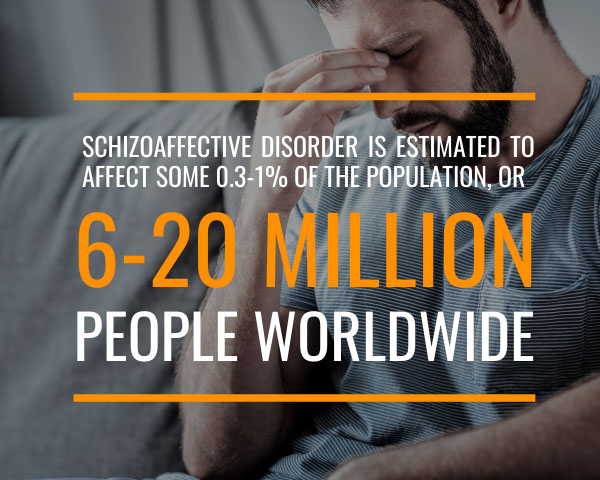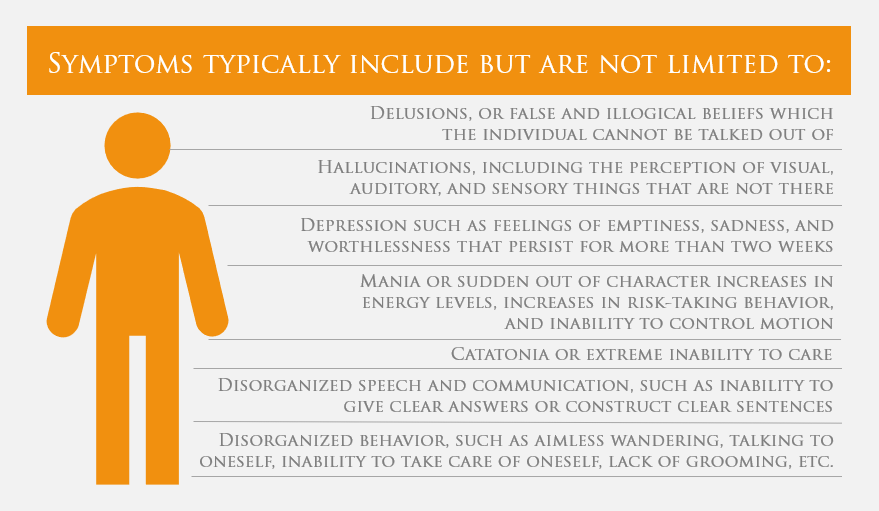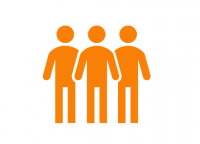
Schizoaffective disorder is estimated to affect some 0.3-1% of the population, or 6-20 million people worldwide. It’s also a controversial disorder, with diagnoses and qualifications radically changing with each new Diagnostic and Statistical Manual (DSM), meaning that individuals who qualified for schizoaffective disorder pre-DSM-5 may be diagnosed as schizophrenic, depressed, or as bipolar. Schizoaffective disorder typically includes individuals who don’t meet qualifications for schizophrenia, bipolar disorder, or depression, but rather have some of the symptoms of each.
While difficult to diagnose, schizoaffective disorder massively impacts the lives and quality of life of people who struggle with it. If you or a loved one is struggling, seeking out a diagnosis, medication, and therapy can help.
Common Symptoms of Schizoaffective Disorder
Schizoaffective disorder can have greatly varying symptoms, especially depending on the type or subset of the disorder. The DSM 5 rules that individuals must have at least two symptoms of depression or bipolar disorder and at least one symptom of schizophrenia to warrant a diagnosis.

The DSM-5 also rules that individuals must experience at least two separate instances of psychosis (Delusions or mania), which cannot be linked to a substance (prescribed or otherwise) or to another explainable cause (e.g., hyperthyroidism or other physical health problem, or other mental health problem).
Types of Schizoaffective Disorder
Schizoaffective disorder is organized into two types depending on the major symptoms shown. Here, diagnosis may affect treatment in terms of medication, and treatment tin terms of the direction that psychotherapy takes.
Diagnosing Schizoaffective Disorder
Schizoaffective disorder is notoriously difficult to diagnose, not only because it heavily overlaps with other disorders, but also because it has been used inappropriately as a “catch-all” in the past. Today, diagnostic criteria strictly require that individuals have conspicuous overlaps in psychosis and depression or mania in order to qualify for schizoaffective disorder. Many of the people diagnosed with schizoaffective disorder pre-2009 now qualify for mood-disorder, psychotic mood disorder, and schizophrenia diagnoses. Therefore, diagnosis can be complex. In most cases, individuals may find that they are diagnosed with depression or a bipolar disorder before receiving their full diagnosis.
Getting Treatment for Schizoaffective Disorder
Schizoaffective disorder is primarily treated with medication, with complimentary therapies including behavioral therapy, individual therapy, counseling, skills training, and, in extreme cases, hospitalization. Schizoaffective disorder patients are at a high risk of complications including anxiety, substance use disorder, suicidal ideation, and physical health problems.
Like with bipolar disorder, depression, and schizophrenia, schizoaffective disorder can heavily impact quality of life and physical health of individuals. For this reason, individuals may receive treatment for symptoms and side effects alongside treatment for the disorder.

Medicine for Schizoaffective Disorder
Schizoaffective disorder is treated using medication to reduce psychosis and mania. At present, there is one FDA approved drug to treat Schizoaffective disorder as a whole. This drug, paliperidone extended release, is sold under the brand name Invega. Paliperidone may be prescribed as a monotreatment or alongside other drugs. Schizoaffective disorder is also treated using:
In addition, you may temporarily receive medications to treat anxiety, to reduce physical side effects, or to treat other complications. In most cases, individuals will only start therapy after beginning medication and after ceasing symptoms of psychosis.
Therapy for Schizoaffective Disorder

Therapy is “second stage” treatment for schizoaffective disorder and is typically carried out in a non-hospital setting such as residential treatment clinic or in outpatient form from the individual’s home. Persons with a high risk of suicide or who are a danger to others and those with a physical dependence on a substance may be recommended for hospital care. Individuals with high levels of psychosis may be recommended for hospital care or residential care during initial treatment of the medication.
Therapy is designed to help persons with schizoaffective disorder to manage symptoms, to better control their emotional state, to recognize when symptoms are problematic, and to develop life skills which might help them to live a happier and more autonomous life.
 Psychotherapy – Psychotherapy includes behavioral therapy such as CBT, DBT, EMDR, family therapy, and motivational training. Psychotherapy examines behavior, including thought patterns and emotional perception and helps the individual to establish new patterns and new behaviors that better serve them and their goals.
Psychotherapy – Psychotherapy includes behavioral therapy such as CBT, DBT, EMDR, family therapy, and motivational training. Psychotherapy examines behavior, including thought patterns and emotional perception and helps the individual to establish new patterns and new behaviors that better serve them and their goals.
This might include reestablishing and rebuilding relationships, helping individuals cope with trauma, helping individuals cope with symptoms, establishing healthy coping mechanisms, and building healthy emotional regulation and management.
 Skills Training – Skills training incorporates self-care and social skills, such as nutrition, grooming, interpersonal relationship management, job reintegration, cooking, etc. These skills can be essential in helping individuals with schizoaffective disorder to live autonomously and to improve quality of life.
Skills Training – Skills training incorporates self-care and social skills, such as nutrition, grooming, interpersonal relationship management, job reintegration, cooking, etc. These skills can be essential in helping individuals with schizoaffective disorder to live autonomously and to improve quality of life.
Here, many people with severe schizoaffective disorder may want to seek out residential treatment, where they stay for 30-90 days in a clinic or home, attend group therapy with peers, and are fully immersed in learning and therapy while in a safe space. Persons who want to continue going home, going to work, school, or attending to responsibilities typically utilize outpatient therapy, which offers a lighter workload and less personalization, but more free time.
Treatment for Schizoaffective Disorder
If you or a loved one has been diagnosed with schizoaffective disorder, it’s important to get help. Medication and stabilizing psychosis is the first step, after which most people greatly benefit from therapy and skills training. In some cases, you may need lifelong counseling or even support from a group home to enable autonomous living outside of a hospital. In other cases, you may be able to move from therapy to living autonomously with relative ease, providing you continue therapy and medication.
Schizoaffective disorder is complex, its definitions and impact vary, and diagnosing it is often difficult. However, most people greatly benefit from getting a diagnosis, taking medication, and eventually seeking therapy and counseling, because these improve quality of life, relationship stability, and life stability, eventually resulting in improved health, happiness, and improved lifespan.
